Comprehensive Analysis of Sales Planning and Operations at John Lewis
VerifiedAdded on 2020/01/23
|12
|3964
|50
Report
AI Summary
This report provides a comprehensive analysis of sales planning and operations at John Lewis, a major UK department store chain. It explores the importance of personal selling in supporting the promotional mix, examining buyer behavior and the decision-making process in various situations. The report delves into the role of sales teams within marketing strategy, discussing market segments and strategic approaches. Key aspects of sales strategy development are covered, including alignment with corporate objectives, recruitment and selection procedures, and the importance of motivation, remuneration, and training in sales management. The report also addresses organizing sales activities, sales output control, and the use of databases in effective sales management. Furthermore, it includes a sales plan for a product or service and discusses opportunities for international selling and the use of exhibitions or trade fairs. Overall, the report offers a detailed overview of the sales planning and operational strategies employed by John Lewis, providing valuable insights into their approach to sales and marketing.
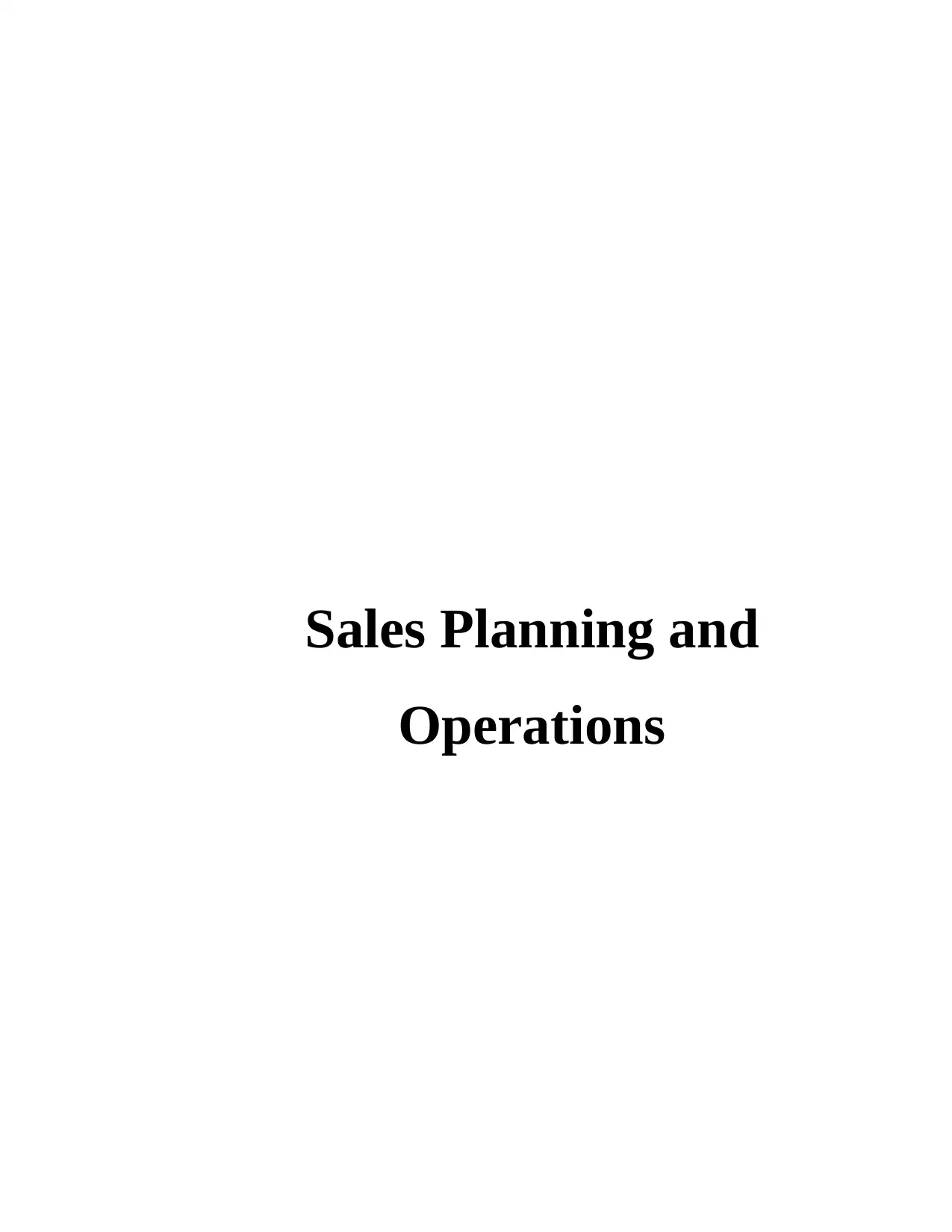
Sales Planning and
Operations
Operations
Paraphrase This Document
Need a fresh take? Get an instant paraphrase of this document with our AI Paraphraser
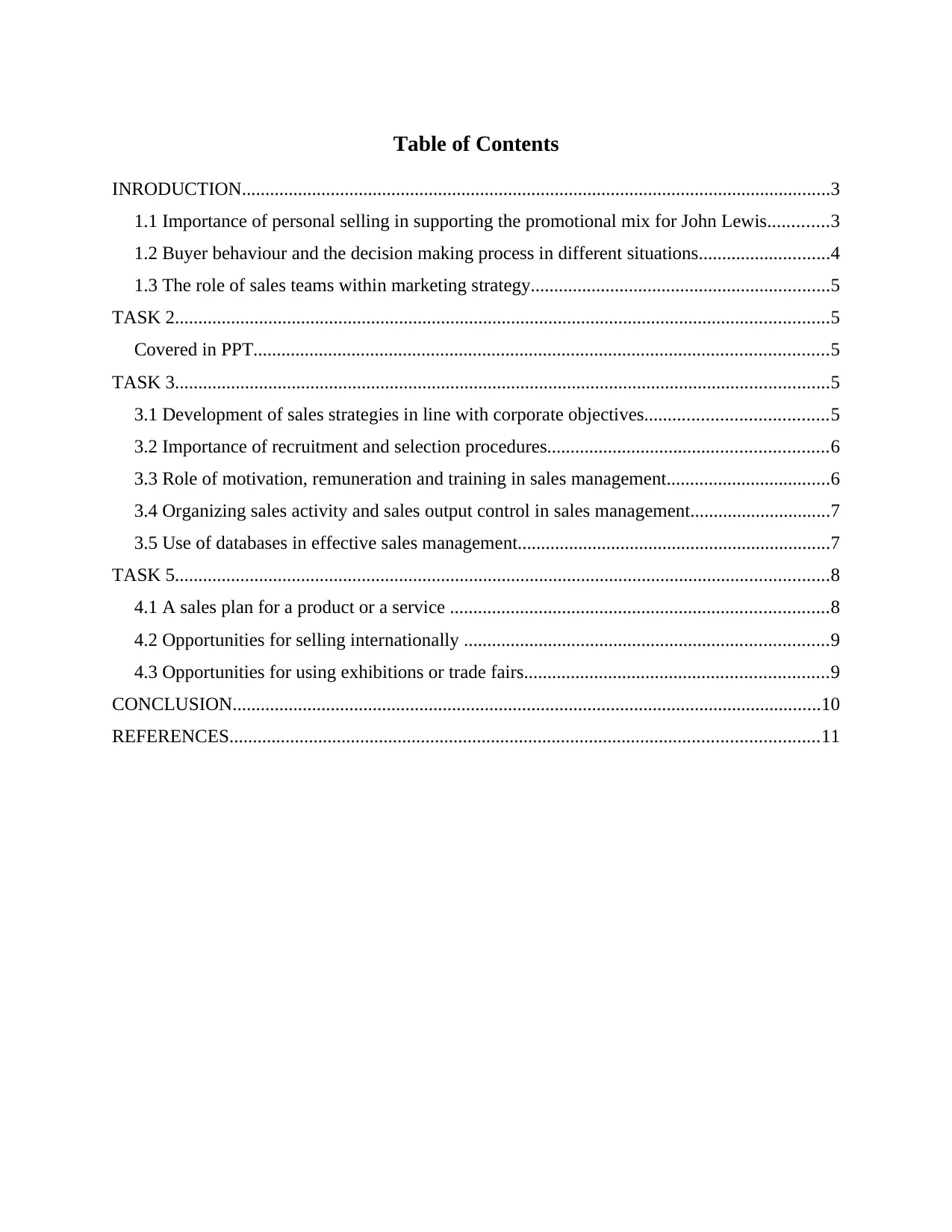
Table of Contents
INRODUCTION..............................................................................................................................3
1.1 Importance of personal selling in supporting the promotional mix for John Lewis.............3
1.2 Buyer behaviour and the decision making process in different situations............................4
1.3 The role of sales teams within marketing strategy................................................................5
TASK 2............................................................................................................................................5
Covered in PPT...........................................................................................................................5
TASK 3............................................................................................................................................5
3.1 Development of sales strategies in line with corporate objectives.......................................5
3.2 Importance of recruitment and selection procedures............................................................6
3.3 Role of motivation, remuneration and training in sales management...................................6
3.4 Organizing sales activity and sales output control in sales management..............................7
3.5 Use of databases in effective sales management...................................................................7
TASK 5............................................................................................................................................8
4.1 A sales plan for a product or a service .................................................................................8
4.2 Opportunities for selling internationally ..............................................................................9
4.3 Opportunities for using exhibitions or trade fairs.................................................................9
CONCLUSION..............................................................................................................................10
REFERENCES..............................................................................................................................11
INRODUCTION..............................................................................................................................3
1.1 Importance of personal selling in supporting the promotional mix for John Lewis.............3
1.2 Buyer behaviour and the decision making process in different situations............................4
1.3 The role of sales teams within marketing strategy................................................................5
TASK 2............................................................................................................................................5
Covered in PPT...........................................................................................................................5
TASK 3............................................................................................................................................5
3.1 Development of sales strategies in line with corporate objectives.......................................5
3.2 Importance of recruitment and selection procedures............................................................6
3.3 Role of motivation, remuneration and training in sales management...................................6
3.4 Organizing sales activity and sales output control in sales management..............................7
3.5 Use of databases in effective sales management...................................................................7
TASK 5............................................................................................................................................8
4.1 A sales plan for a product or a service .................................................................................8
4.2 Opportunities for selling internationally ..............................................................................9
4.3 Opportunities for using exhibitions or trade fairs.................................................................9
CONCLUSION..............................................................................................................................10
REFERENCES..............................................................................................................................11
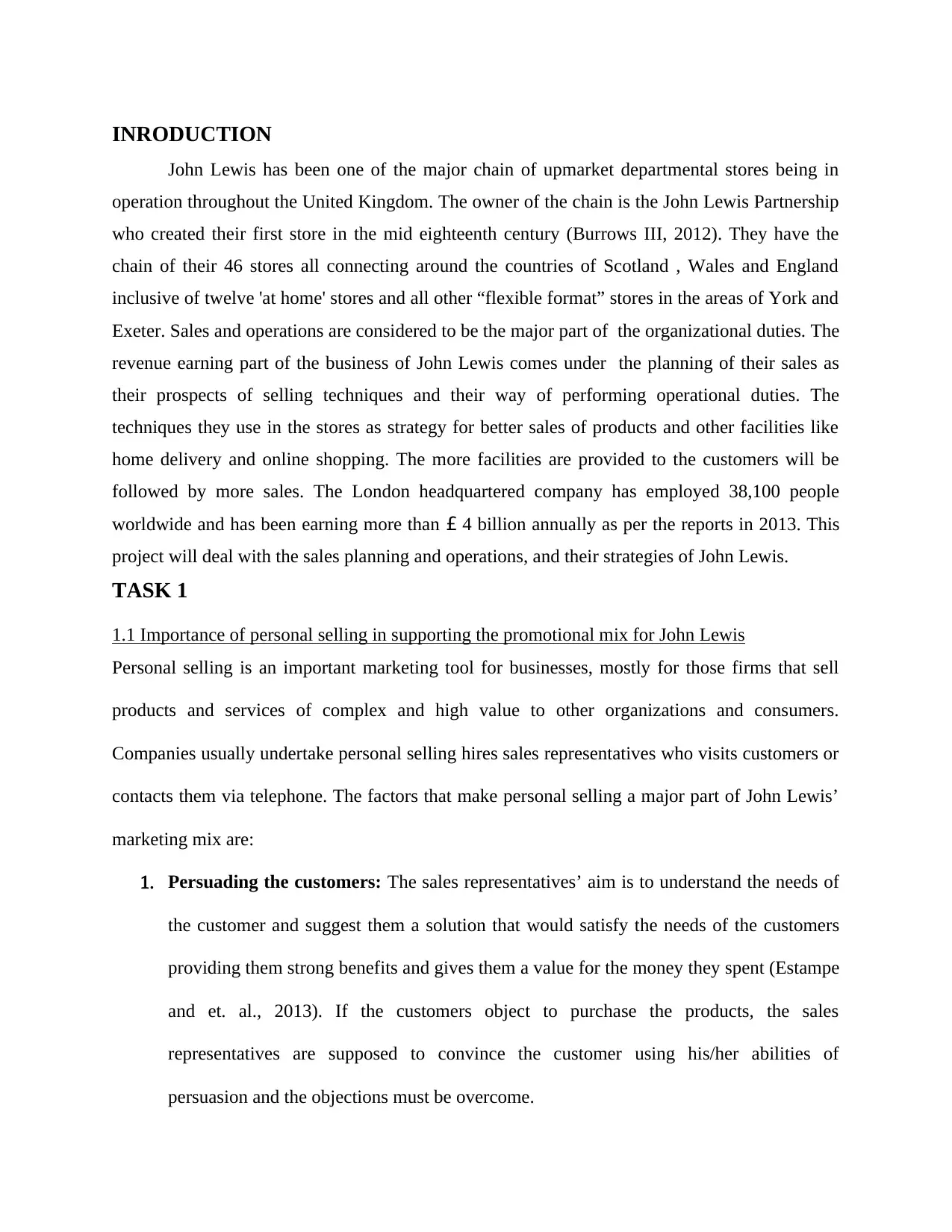
INRODUCTION
John Lewis has been one of the major chain of upmarket departmental stores being in
operation throughout the United Kingdom. The owner of the chain is the John Lewis Partnership
who created their first store in the mid eighteenth century (Burrows III, 2012). They have the
chain of their 46 stores all connecting around the countries of Scotland , Wales and England
inclusive of twelve 'at home' stores and all other “flexible format” stores in the areas of York and
Exeter. Sales and operations are considered to be the major part of the organizational duties. The
revenue earning part of the business of John Lewis comes under the planning of their sales as
their prospects of selling techniques and their way of performing operational duties. The
techniques they use in the stores as strategy for better sales of products and other facilities like
home delivery and online shopping. The more facilities are provided to the customers will be
followed by more sales. The London headquartered company has employed 38,100 people
worldwide and has been earning more than £ 4 billion annually as per the reports in 2013. This
project will deal with the sales planning and operations, and their strategies of John Lewis.
TASK 1
1.1 Importance of personal selling in supporting the promotional mix for John Lewis
Personal selling is an important marketing tool for businesses, mostly for those firms that sell
products and services of complex and high value to other organizations and consumers.
Companies usually undertake personal selling hires sales representatives who visits customers or
contacts them via telephone. The factors that make personal selling a major part of John Lewis’
marketing mix are:
1. Persuading the customers: The sales representatives’ aim is to understand the needs of
the customer and suggest them a solution that would satisfy the needs of the customers
providing them strong benefits and gives them a value for the money they spent (Estampe
and et. al., 2013). If the customers object to purchase the products, the sales
representatives are supposed to convince the customer using his/her abilities of
persuasion and the objections must be overcome.
John Lewis has been one of the major chain of upmarket departmental stores being in
operation throughout the United Kingdom. The owner of the chain is the John Lewis Partnership
who created their first store in the mid eighteenth century (Burrows III, 2012). They have the
chain of their 46 stores all connecting around the countries of Scotland , Wales and England
inclusive of twelve 'at home' stores and all other “flexible format” stores in the areas of York and
Exeter. Sales and operations are considered to be the major part of the organizational duties. The
revenue earning part of the business of John Lewis comes under the planning of their sales as
their prospects of selling techniques and their way of performing operational duties. The
techniques they use in the stores as strategy for better sales of products and other facilities like
home delivery and online shopping. The more facilities are provided to the customers will be
followed by more sales. The London headquartered company has employed 38,100 people
worldwide and has been earning more than £ 4 billion annually as per the reports in 2013. This
project will deal with the sales planning and operations, and their strategies of John Lewis.
TASK 1
1.1 Importance of personal selling in supporting the promotional mix for John Lewis
Personal selling is an important marketing tool for businesses, mostly for those firms that sell
products and services of complex and high value to other organizations and consumers.
Companies usually undertake personal selling hires sales representatives who visits customers or
contacts them via telephone. The factors that make personal selling a major part of John Lewis’
marketing mix are:
1. Persuading the customers: The sales representatives’ aim is to understand the needs of
the customer and suggest them a solution that would satisfy the needs of the customers
providing them strong benefits and gives them a value for the money they spent (Estampe
and et. al., 2013). If the customers object to purchase the products, the sales
representatives are supposed to convince the customer using his/her abilities of
persuasion and the objections must be overcome.
⊘ This is a preview!⊘
Do you want full access?
Subscribe today to unlock all pages.

Trusted by 1+ million students worldwide
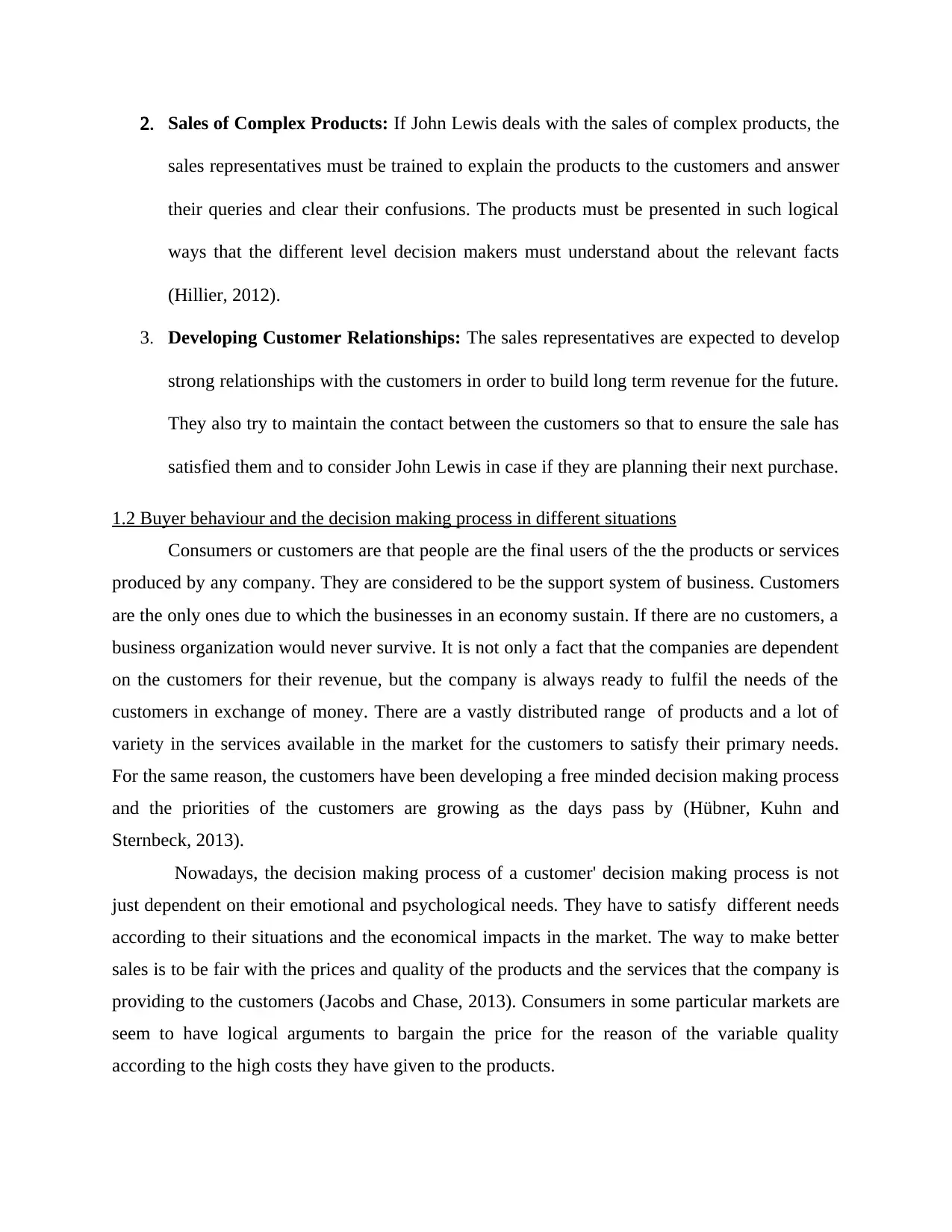
2. Sales of Complex Products: If John Lewis deals with the sales of complex products, the
sales representatives must be trained to explain the products to the customers and answer
their queries and clear their confusions. The products must be presented in such logical
ways that the different level decision makers must understand about the relevant facts
(Hillier, 2012).
3. Developing Customer Relationships: The sales representatives are expected to develop
strong relationships with the customers in order to build long term revenue for the future.
They also try to maintain the contact between the customers so that to ensure the sale has
satisfied them and to consider John Lewis in case if they are planning their next purchase.
1.2 Buyer behaviour and the decision making process in different situations
Consumers or customers are that people are the final users of the the products or services
produced by any company. They are considered to be the support system of business. Customers
are the only ones due to which the businesses in an economy sustain. If there are no customers, a
business organization would never survive. It is not only a fact that the companies are dependent
on the customers for their revenue, but the company is always ready to fulfil the needs of the
customers in exchange of money. There are a vastly distributed range of products and a lot of
variety in the services available in the market for the customers to satisfy their primary needs.
For the same reason, the customers have been developing a free minded decision making process
and the priorities of the customers are growing as the days pass by (Hübner, Kuhn and
Sternbeck, 2013).
Nowadays, the decision making process of a customer' decision making process is not
just dependent on their emotional and psychological needs. They have to satisfy different needs
according to their situations and the economical impacts in the market. The way to make better
sales is to be fair with the prices and quality of the products and the services that the company is
providing to the customers (Jacobs and Chase, 2013). Consumers in some particular markets are
seem to have logical arguments to bargain the price for the reason of the variable quality
according to the high costs they have given to the products.
sales representatives must be trained to explain the products to the customers and answer
their queries and clear their confusions. The products must be presented in such logical
ways that the different level decision makers must understand about the relevant facts
(Hillier, 2012).
3. Developing Customer Relationships: The sales representatives are expected to develop
strong relationships with the customers in order to build long term revenue for the future.
They also try to maintain the contact between the customers so that to ensure the sale has
satisfied them and to consider John Lewis in case if they are planning their next purchase.
1.2 Buyer behaviour and the decision making process in different situations
Consumers or customers are that people are the final users of the the products or services
produced by any company. They are considered to be the support system of business. Customers
are the only ones due to which the businesses in an economy sustain. If there are no customers, a
business organization would never survive. It is not only a fact that the companies are dependent
on the customers for their revenue, but the company is always ready to fulfil the needs of the
customers in exchange of money. There are a vastly distributed range of products and a lot of
variety in the services available in the market for the customers to satisfy their primary needs.
For the same reason, the customers have been developing a free minded decision making process
and the priorities of the customers are growing as the days pass by (Hübner, Kuhn and
Sternbeck, 2013).
Nowadays, the decision making process of a customer' decision making process is not
just dependent on their emotional and psychological needs. They have to satisfy different needs
according to their situations and the economical impacts in the market. The way to make better
sales is to be fair with the prices and quality of the products and the services that the company is
providing to the customers (Jacobs and Chase, 2013). Consumers in some particular markets are
seem to have logical arguments to bargain the price for the reason of the variable quality
according to the high costs they have given to the products.
Paraphrase This Document
Need a fresh take? Get an instant paraphrase of this document with our AI Paraphraser
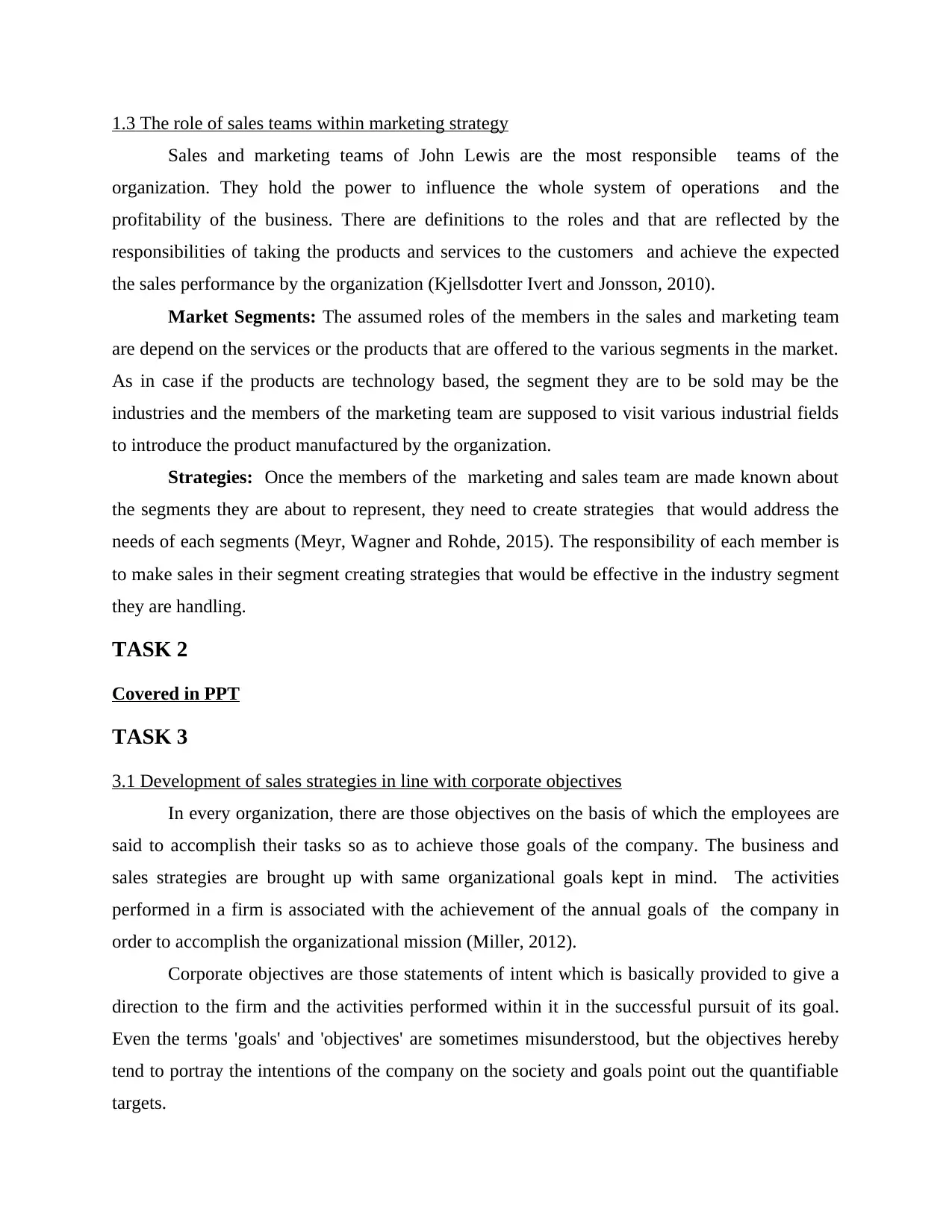
1.3 The role of sales teams within marketing strategy
Sales and marketing teams of John Lewis are the most responsible teams of the
organization. They hold the power to influence the whole system of operations and the
profitability of the business. There are definitions to the roles and that are reflected by the
responsibilities of taking the products and services to the customers and achieve the expected
the sales performance by the organization (Kjellsdotter Ivert and Jonsson, 2010).
Market Segments: The assumed roles of the members in the sales and marketing team
are depend on the services or the products that are offered to the various segments in the market.
As in case if the products are technology based, the segment they are to be sold may be the
industries and the members of the marketing team are supposed to visit various industrial fields
to introduce the product manufactured by the organization.
Strategies: Once the members of the marketing and sales team are made known about
the segments they are about to represent, they need to create strategies that would address the
needs of each segments (Meyr, Wagner and Rohde, 2015). The responsibility of each member is
to make sales in their segment creating strategies that would be effective in the industry segment
they are handling.
TASK 2
Covered in PPT
TASK 3
3.1 Development of sales strategies in line with corporate objectives
In every organization, there are those objectives on the basis of which the employees are
said to accomplish their tasks so as to achieve those goals of the company. The business and
sales strategies are brought up with same organizational goals kept in mind. The activities
performed in a firm is associated with the achievement of the annual goals of the company in
order to accomplish the organizational mission (Miller, 2012).
Corporate objectives are those statements of intent which is basically provided to give a
direction to the firm and the activities performed within it in the successful pursuit of its goal.
Even the terms 'goals' and 'objectives' are sometimes misunderstood, but the objectives hereby
tend to portray the intentions of the company on the society and goals point out the quantifiable
targets.
Sales and marketing teams of John Lewis are the most responsible teams of the
organization. They hold the power to influence the whole system of operations and the
profitability of the business. There are definitions to the roles and that are reflected by the
responsibilities of taking the products and services to the customers and achieve the expected
the sales performance by the organization (Kjellsdotter Ivert and Jonsson, 2010).
Market Segments: The assumed roles of the members in the sales and marketing team
are depend on the services or the products that are offered to the various segments in the market.
As in case if the products are technology based, the segment they are to be sold may be the
industries and the members of the marketing team are supposed to visit various industrial fields
to introduce the product manufactured by the organization.
Strategies: Once the members of the marketing and sales team are made known about
the segments they are about to represent, they need to create strategies that would address the
needs of each segments (Meyr, Wagner and Rohde, 2015). The responsibility of each member is
to make sales in their segment creating strategies that would be effective in the industry segment
they are handling.
TASK 2
Covered in PPT
TASK 3
3.1 Development of sales strategies in line with corporate objectives
In every organization, there are those objectives on the basis of which the employees are
said to accomplish their tasks so as to achieve those goals of the company. The business and
sales strategies are brought up with same organizational goals kept in mind. The activities
performed in a firm is associated with the achievement of the annual goals of the company in
order to accomplish the organizational mission (Miller, 2012).
Corporate objectives are those statements of intent which is basically provided to give a
direction to the firm and the activities performed within it in the successful pursuit of its goal.
Even the terms 'goals' and 'objectives' are sometimes misunderstood, but the objectives hereby
tend to portray the intentions of the company on the society and goals point out the quantifiable
targets.
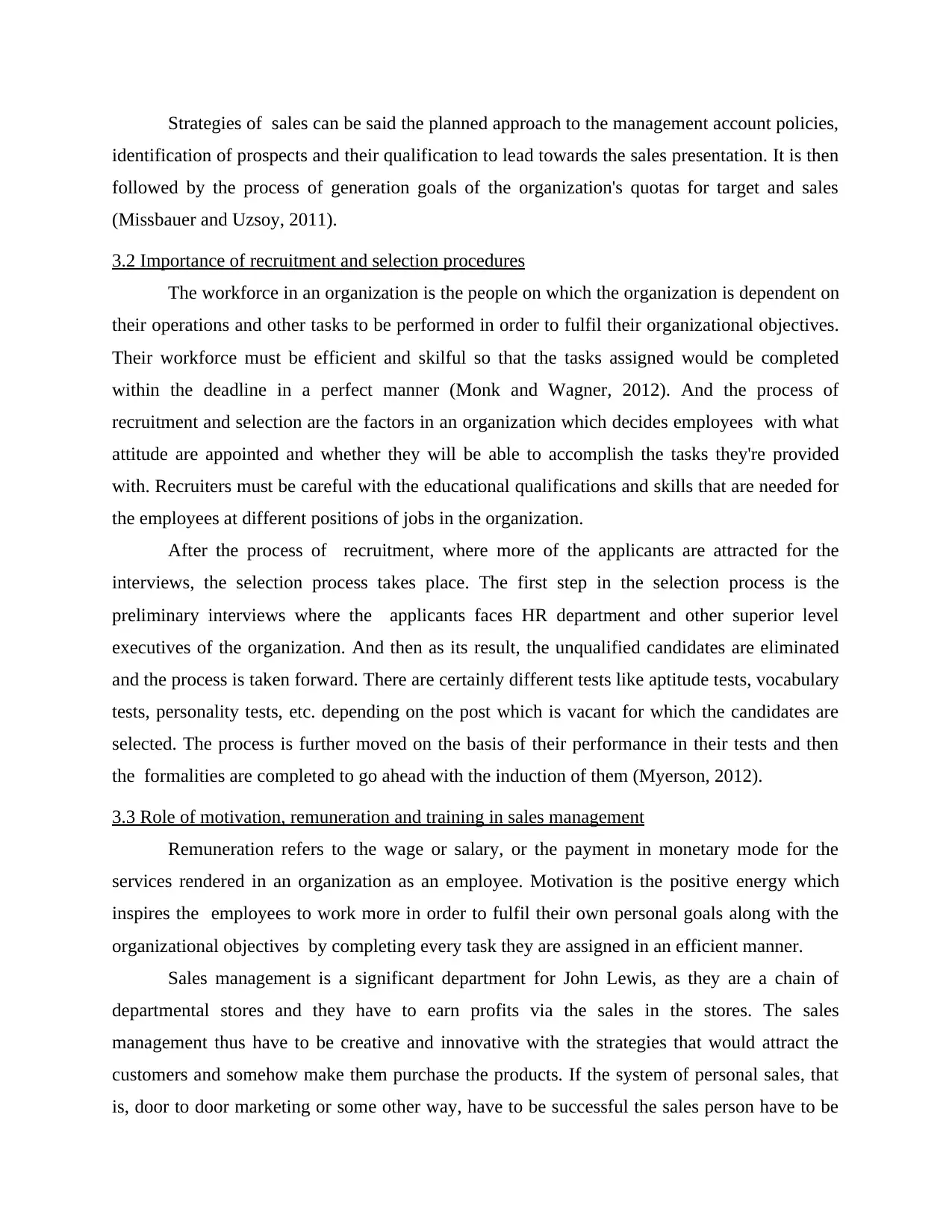
Strategies of sales can be said the planned approach to the management account policies,
identification of prospects and their qualification to lead towards the sales presentation. It is then
followed by the process of generation goals of the organization's quotas for target and sales
(Missbauer and Uzsoy, 2011).
3.2 Importance of recruitment and selection procedures
The workforce in an organization is the people on which the organization is dependent on
their operations and other tasks to be performed in order to fulfil their organizational objectives.
Their workforce must be efficient and skilful so that the tasks assigned would be completed
within the deadline in a perfect manner (Monk and Wagner, 2012). And the process of
recruitment and selection are the factors in an organization which decides employees with what
attitude are appointed and whether they will be able to accomplish the tasks they're provided
with. Recruiters must be careful with the educational qualifications and skills that are needed for
the employees at different positions of jobs in the organization.
After the process of recruitment, where more of the applicants are attracted for the
interviews, the selection process takes place. The first step in the selection process is the
preliminary interviews where the applicants faces HR department and other superior level
executives of the organization. And then as its result, the unqualified candidates are eliminated
and the process is taken forward. There are certainly different tests like aptitude tests, vocabulary
tests, personality tests, etc. depending on the post which is vacant for which the candidates are
selected. The process is further moved on the basis of their performance in their tests and then
the formalities are completed to go ahead with the induction of them (Myerson, 2012).
3.3 Role of motivation, remuneration and training in sales management
Remuneration refers to the wage or salary, or the payment in monetary mode for the
services rendered in an organization as an employee. Motivation is the positive energy which
inspires the employees to work more in order to fulfil their own personal goals along with the
organizational objectives by completing every task they are assigned in an efficient manner.
Sales management is a significant department for John Lewis, as they are a chain of
departmental stores and they have to earn profits via the sales in the stores. The sales
management thus have to be creative and innovative with the strategies that would attract the
customers and somehow make them purchase the products. If the system of personal sales, that
is, door to door marketing or some other way, have to be successful the sales person have to be
identification of prospects and their qualification to lead towards the sales presentation. It is then
followed by the process of generation goals of the organization's quotas for target and sales
(Missbauer and Uzsoy, 2011).
3.2 Importance of recruitment and selection procedures
The workforce in an organization is the people on which the organization is dependent on
their operations and other tasks to be performed in order to fulfil their organizational objectives.
Their workforce must be efficient and skilful so that the tasks assigned would be completed
within the deadline in a perfect manner (Monk and Wagner, 2012). And the process of
recruitment and selection are the factors in an organization which decides employees with what
attitude are appointed and whether they will be able to accomplish the tasks they're provided
with. Recruiters must be careful with the educational qualifications and skills that are needed for
the employees at different positions of jobs in the organization.
After the process of recruitment, where more of the applicants are attracted for the
interviews, the selection process takes place. The first step in the selection process is the
preliminary interviews where the applicants faces HR department and other superior level
executives of the organization. And then as its result, the unqualified candidates are eliminated
and the process is taken forward. There are certainly different tests like aptitude tests, vocabulary
tests, personality tests, etc. depending on the post which is vacant for which the candidates are
selected. The process is further moved on the basis of their performance in their tests and then
the formalities are completed to go ahead with the induction of them (Myerson, 2012).
3.3 Role of motivation, remuneration and training in sales management
Remuneration refers to the wage or salary, or the payment in monetary mode for the
services rendered in an organization as an employee. Motivation is the positive energy which
inspires the employees to work more in order to fulfil their own personal goals along with the
organizational objectives by completing every task they are assigned in an efficient manner.
Sales management is a significant department for John Lewis, as they are a chain of
departmental stores and they have to earn profits via the sales in the stores. The sales
management thus have to be creative and innovative with the strategies that would attract the
customers and somehow make them purchase the products. If the system of personal sales, that
is, door to door marketing or some other way, have to be successful the sales person have to be
⊘ This is a preview!⊘
Do you want full access?
Subscribe today to unlock all pages.

Trusted by 1+ million students worldwide
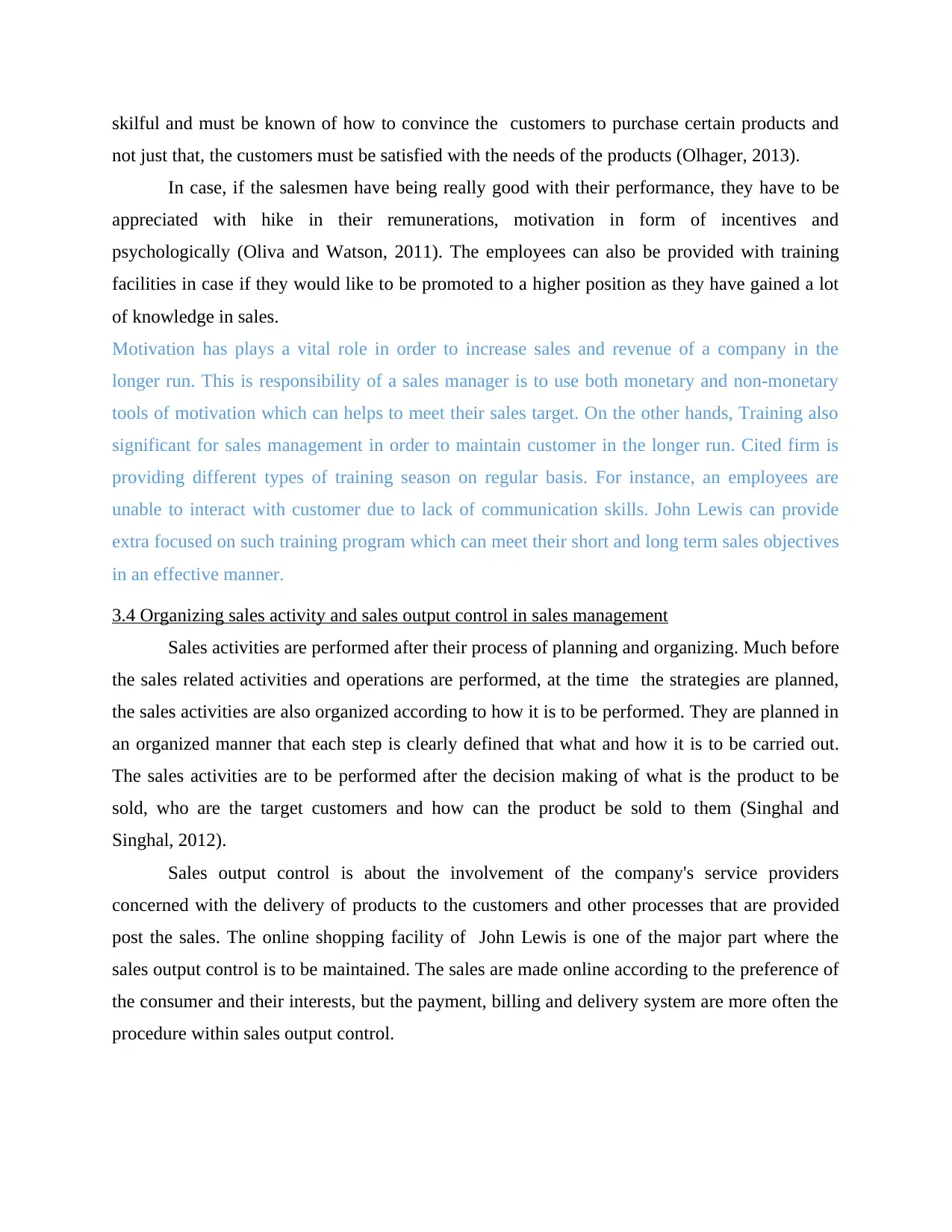
skilful and must be known of how to convince the customers to purchase certain products and
not just that, the customers must be satisfied with the needs of the products (Olhager, 2013).
In case, if the salesmen have being really good with their performance, they have to be
appreciated with hike in their remunerations, motivation in form of incentives and
psychologically (Oliva and Watson, 2011). The employees can also be provided with training
facilities in case if they would like to be promoted to a higher position as they have gained a lot
of knowledge in sales.
Motivation has plays a vital role in order to increase sales and revenue of a company in the
longer run. This is responsibility of a sales manager is to use both monetary and non-monetary
tools of motivation which can helps to meet their sales target. On the other hands, Training also
significant for sales management in order to maintain customer in the longer run. Cited firm is
providing different types of training season on regular basis. For instance, an employees are
unable to interact with customer due to lack of communication skills. John Lewis can provide
extra focused on such training program which can meet their short and long term sales objectives
in an effective manner.
3.4 Organizing sales activity and sales output control in sales management
Sales activities are performed after their process of planning and organizing. Much before
the sales related activities and operations are performed, at the time the strategies are planned,
the sales activities are also organized according to how it is to be performed. They are planned in
an organized manner that each step is clearly defined that what and how it is to be carried out.
The sales activities are to be performed after the decision making of what is the product to be
sold, who are the target customers and how can the product be sold to them (Singhal and
Singhal, 2012).
Sales output control is about the involvement of the company's service providers
concerned with the delivery of products to the customers and other processes that are provided
post the sales. The online shopping facility of John Lewis is one of the major part where the
sales output control is to be maintained. The sales are made online according to the preference of
the consumer and their interests, but the payment, billing and delivery system are more often the
procedure within sales output control.
not just that, the customers must be satisfied with the needs of the products (Olhager, 2013).
In case, if the salesmen have being really good with their performance, they have to be
appreciated with hike in their remunerations, motivation in form of incentives and
psychologically (Oliva and Watson, 2011). The employees can also be provided with training
facilities in case if they would like to be promoted to a higher position as they have gained a lot
of knowledge in sales.
Motivation has plays a vital role in order to increase sales and revenue of a company in the
longer run. This is responsibility of a sales manager is to use both monetary and non-monetary
tools of motivation which can helps to meet their sales target. On the other hands, Training also
significant for sales management in order to maintain customer in the longer run. Cited firm is
providing different types of training season on regular basis. For instance, an employees are
unable to interact with customer due to lack of communication skills. John Lewis can provide
extra focused on such training program which can meet their short and long term sales objectives
in an effective manner.
3.4 Organizing sales activity and sales output control in sales management
Sales activities are performed after their process of planning and organizing. Much before
the sales related activities and operations are performed, at the time the strategies are planned,
the sales activities are also organized according to how it is to be performed. They are planned in
an organized manner that each step is clearly defined that what and how it is to be carried out.
The sales activities are to be performed after the decision making of what is the product to be
sold, who are the target customers and how can the product be sold to them (Singhal and
Singhal, 2012).
Sales output control is about the involvement of the company's service providers
concerned with the delivery of products to the customers and other processes that are provided
post the sales. The online shopping facility of John Lewis is one of the major part where the
sales output control is to be maintained. The sales are made online according to the preference of
the consumer and their interests, but the payment, billing and delivery system are more often the
procedure within sales output control.
Paraphrase This Document
Need a fresh take? Get an instant paraphrase of this document with our AI Paraphraser
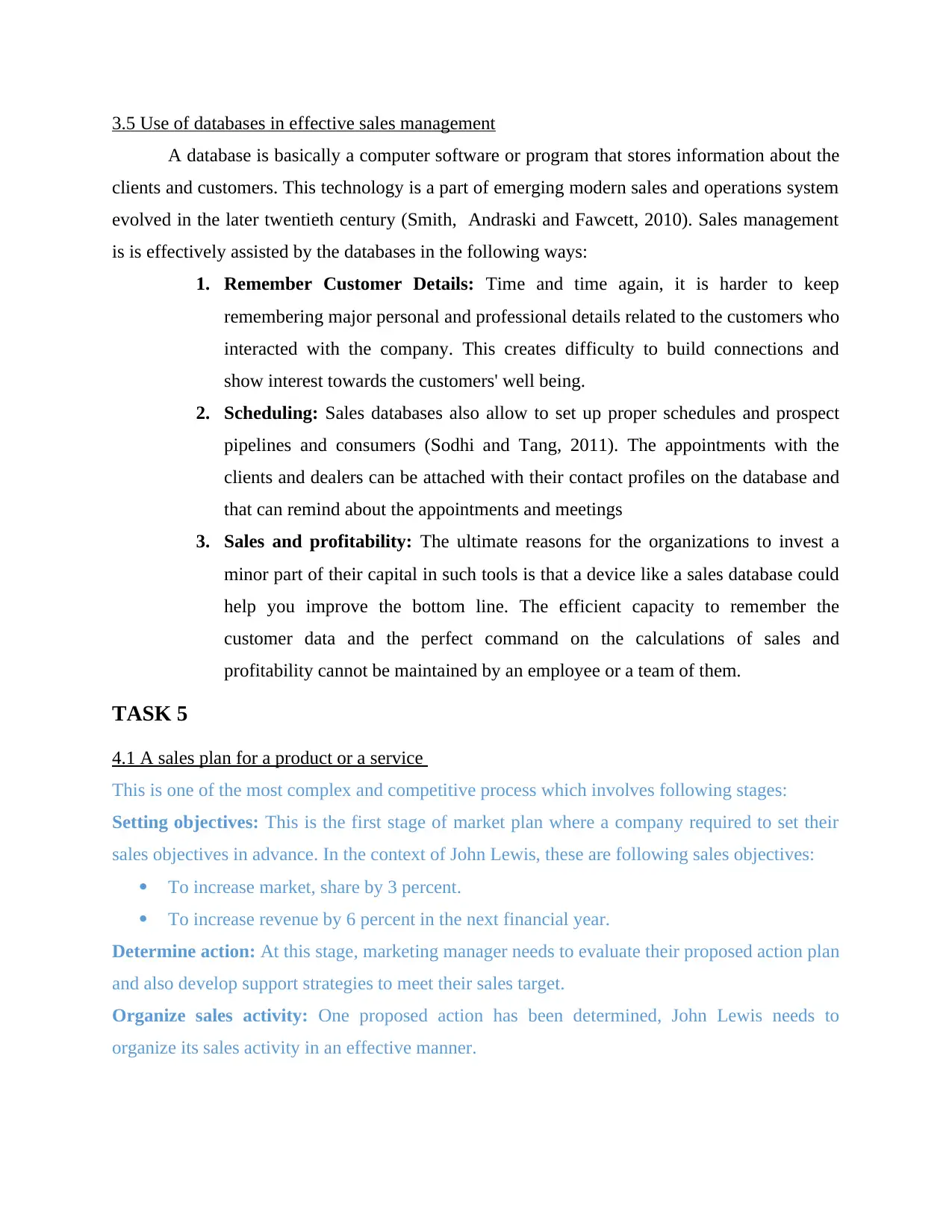
3.5 Use of databases in effective sales management
A database is basically a computer software or program that stores information about the
clients and customers. This technology is a part of emerging modern sales and operations system
evolved in the later twentieth century (Smith, Andraski and Fawcett, 2010). Sales management
is is effectively assisted by the databases in the following ways:
1. Remember Customer Details: Time and time again, it is harder to keep
remembering major personal and professional details related to the customers who
interacted with the company. This creates difficulty to build connections and
show interest towards the customers' well being.
2. Scheduling: Sales databases also allow to set up proper schedules and prospect
pipelines and consumers (Sodhi and Tang, 2011). The appointments with the
clients and dealers can be attached with their contact profiles on the database and
that can remind about the appointments and meetings
3. Sales and profitability: The ultimate reasons for the organizations to invest a
minor part of their capital in such tools is that a device like a sales database could
help you improve the bottom line. The efficient capacity to remember the
customer data and the perfect command on the calculations of sales and
profitability cannot be maintained by an employee or a team of them.
TASK 5
4.1 A sales plan for a product or a service
This is one of the most complex and competitive process which involves following stages:
Setting objectives: This is the first stage of market plan where a company required to set their
sales objectives in advance. In the context of John Lewis, these are following sales objectives:
To increase market, share by 3 percent.
To increase revenue by 6 percent in the next financial year.
Determine action: At this stage, marketing manager needs to evaluate their proposed action plan
and also develop support strategies to meet their sales target.
Organize sales activity: One proposed action has been determined, John Lewis needs to
organize its sales activity in an effective manner.
A database is basically a computer software or program that stores information about the
clients and customers. This technology is a part of emerging modern sales and operations system
evolved in the later twentieth century (Smith, Andraski and Fawcett, 2010). Sales management
is is effectively assisted by the databases in the following ways:
1. Remember Customer Details: Time and time again, it is harder to keep
remembering major personal and professional details related to the customers who
interacted with the company. This creates difficulty to build connections and
show interest towards the customers' well being.
2. Scheduling: Sales databases also allow to set up proper schedules and prospect
pipelines and consumers (Sodhi and Tang, 2011). The appointments with the
clients and dealers can be attached with their contact profiles on the database and
that can remind about the appointments and meetings
3. Sales and profitability: The ultimate reasons for the organizations to invest a
minor part of their capital in such tools is that a device like a sales database could
help you improve the bottom line. The efficient capacity to remember the
customer data and the perfect command on the calculations of sales and
profitability cannot be maintained by an employee or a team of them.
TASK 5
4.1 A sales plan for a product or a service
This is one of the most complex and competitive process which involves following stages:
Setting objectives: This is the first stage of market plan where a company required to set their
sales objectives in advance. In the context of John Lewis, these are following sales objectives:
To increase market, share by 3 percent.
To increase revenue by 6 percent in the next financial year.
Determine action: At this stage, marketing manager needs to evaluate their proposed action plan
and also develop support strategies to meet their sales target.
Organize sales activity: One proposed action has been determined, John Lewis needs to
organize its sales activity in an effective manner.
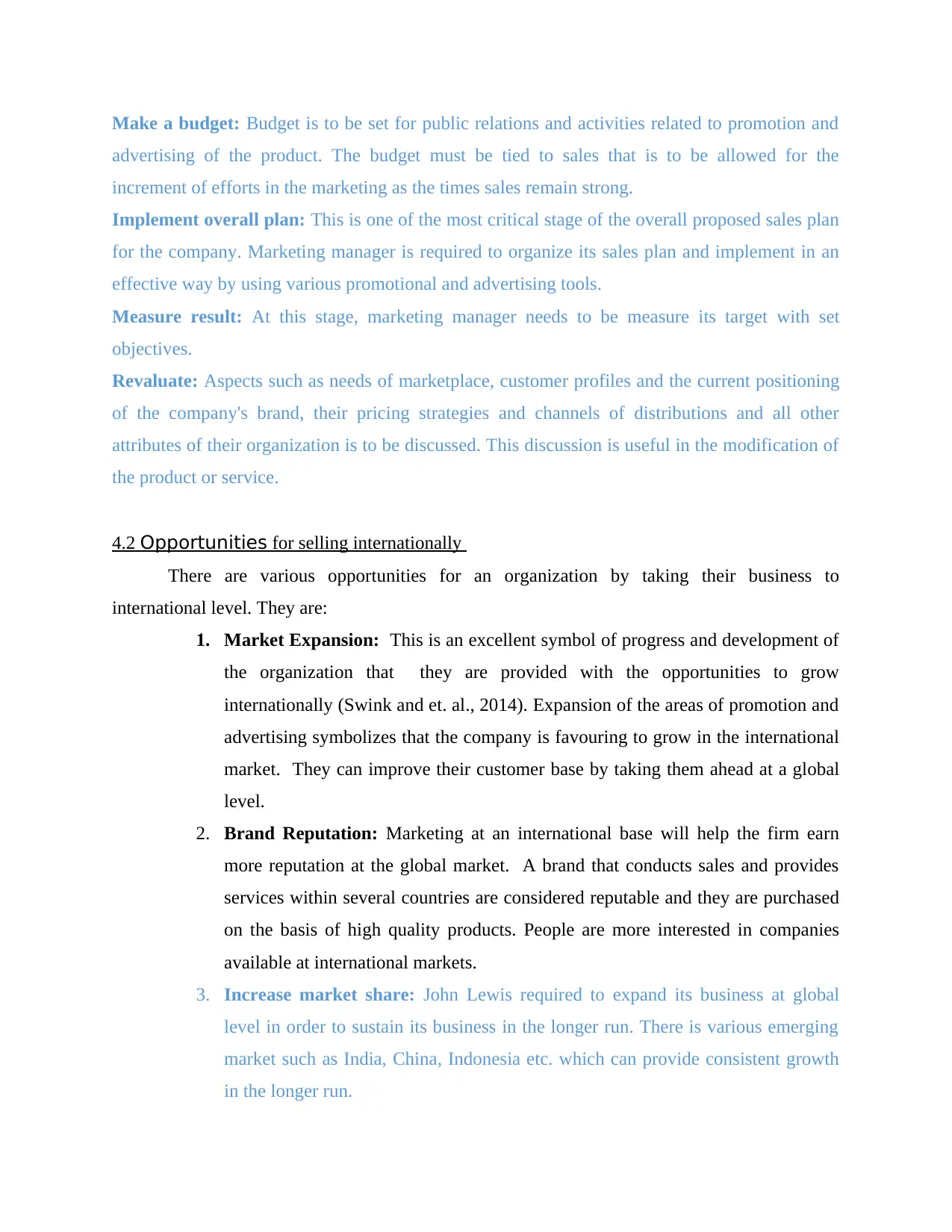
Make a budget: Budget is to be set for public relations and activities related to promotion and
advertising of the product. The budget must be tied to sales that is to be allowed for the
increment of efforts in the marketing as the times sales remain strong.
Implement overall plan: This is one of the most critical stage of the overall proposed sales plan
for the company. Marketing manager is required to organize its sales plan and implement in an
effective way by using various promotional and advertising tools.
Measure result: At this stage, marketing manager needs to be measure its target with set
objectives.
Revaluate: Aspects such as needs of marketplace, customer profiles and the current positioning
of the company's brand, their pricing strategies and channels of distributions and all other
attributes of their organization is to be discussed. This discussion is useful in the modification of
the product or service.
4.2 Opportunities for selling internationally
There are various opportunities for an organization by taking their business to
international level. They are:
1. Market Expansion: This is an excellent symbol of progress and development of
the organization that they are provided with the opportunities to grow
internationally (Swink and et. al., 2014). Expansion of the areas of promotion and
advertising symbolizes that the company is favouring to grow in the international
market. They can improve their customer base by taking them ahead at a global
level.
2. Brand Reputation: Marketing at an international base will help the firm earn
more reputation at the global market. A brand that conducts sales and provides
services within several countries are considered reputable and they are purchased
on the basis of high quality products. People are more interested in companies
available at international markets.
3. Increase market share: John Lewis required to expand its business at global
level in order to sustain its business in the longer run. There is various emerging
market such as India, China, Indonesia etc. which can provide consistent growth
in the longer run.
advertising of the product. The budget must be tied to sales that is to be allowed for the
increment of efforts in the marketing as the times sales remain strong.
Implement overall plan: This is one of the most critical stage of the overall proposed sales plan
for the company. Marketing manager is required to organize its sales plan and implement in an
effective way by using various promotional and advertising tools.
Measure result: At this stage, marketing manager needs to be measure its target with set
objectives.
Revaluate: Aspects such as needs of marketplace, customer profiles and the current positioning
of the company's brand, their pricing strategies and channels of distributions and all other
attributes of their organization is to be discussed. This discussion is useful in the modification of
the product or service.
4.2 Opportunities for selling internationally
There are various opportunities for an organization by taking their business to
international level. They are:
1. Market Expansion: This is an excellent symbol of progress and development of
the organization that they are provided with the opportunities to grow
internationally (Swink and et. al., 2014). Expansion of the areas of promotion and
advertising symbolizes that the company is favouring to grow in the international
market. They can improve their customer base by taking them ahead at a global
level.
2. Brand Reputation: Marketing at an international base will help the firm earn
more reputation at the global market. A brand that conducts sales and provides
services within several countries are considered reputable and they are purchased
on the basis of high quality products. People are more interested in companies
available at international markets.
3. Increase market share: John Lewis required to expand its business at global
level in order to sustain its business in the longer run. There is various emerging
market such as India, China, Indonesia etc. which can provide consistent growth
in the longer run.
⊘ This is a preview!⊘
Do you want full access?
Subscribe today to unlock all pages.

Trusted by 1+ million students worldwide
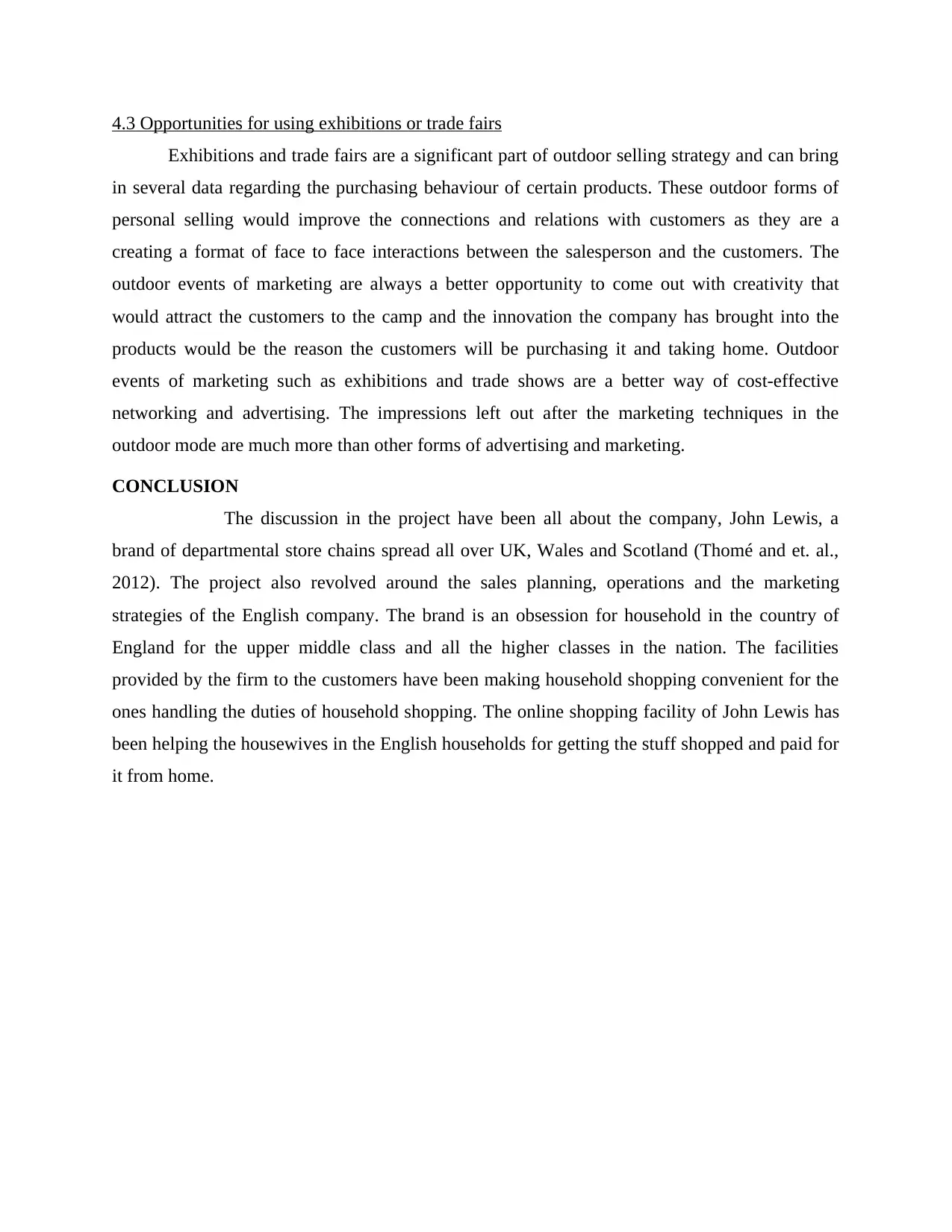
4.3 Opportunities for using exhibitions or trade fairs
Exhibitions and trade fairs are a significant part of outdoor selling strategy and can bring
in several data regarding the purchasing behaviour of certain products. These outdoor forms of
personal selling would improve the connections and relations with customers as they are a
creating a format of face to face interactions between the salesperson and the customers. The
outdoor events of marketing are always a better opportunity to come out with creativity that
would attract the customers to the camp and the innovation the company has brought into the
products would be the reason the customers will be purchasing it and taking home. Outdoor
events of marketing such as exhibitions and trade shows are a better way of cost-effective
networking and advertising. The impressions left out after the marketing techniques in the
outdoor mode are much more than other forms of advertising and marketing.
CONCLUSION
The discussion in the project have been all about the company, John Lewis, a
brand of departmental store chains spread all over UK, Wales and Scotland (Thomé and et. al.,
2012). The project also revolved around the sales planning, operations and the marketing
strategies of the English company. The brand is an obsession for household in the country of
England for the upper middle class and all the higher classes in the nation. The facilities
provided by the firm to the customers have been making household shopping convenient for the
ones handling the duties of household shopping. The online shopping facility of John Lewis has
been helping the housewives in the English households for getting the stuff shopped and paid for
it from home.
Exhibitions and trade fairs are a significant part of outdoor selling strategy and can bring
in several data regarding the purchasing behaviour of certain products. These outdoor forms of
personal selling would improve the connections and relations with customers as they are a
creating a format of face to face interactions between the salesperson and the customers. The
outdoor events of marketing are always a better opportunity to come out with creativity that
would attract the customers to the camp and the innovation the company has brought into the
products would be the reason the customers will be purchasing it and taking home. Outdoor
events of marketing such as exhibitions and trade shows are a better way of cost-effective
networking and advertising. The impressions left out after the marketing techniques in the
outdoor mode are much more than other forms of advertising and marketing.
CONCLUSION
The discussion in the project have been all about the company, John Lewis, a
brand of departmental store chains spread all over UK, Wales and Scotland (Thomé and et. al.,
2012). The project also revolved around the sales planning, operations and the marketing
strategies of the English company. The brand is an obsession for household in the country of
England for the upper middle class and all the higher classes in the nation. The facilities
provided by the firm to the customers have been making household shopping convenient for the
ones handling the duties of household shopping. The online shopping facility of John Lewis has
been helping the housewives in the English households for getting the stuff shopped and paid for
it from home.
Paraphrase This Document
Need a fresh take? Get an instant paraphrase of this document with our AI Paraphraser
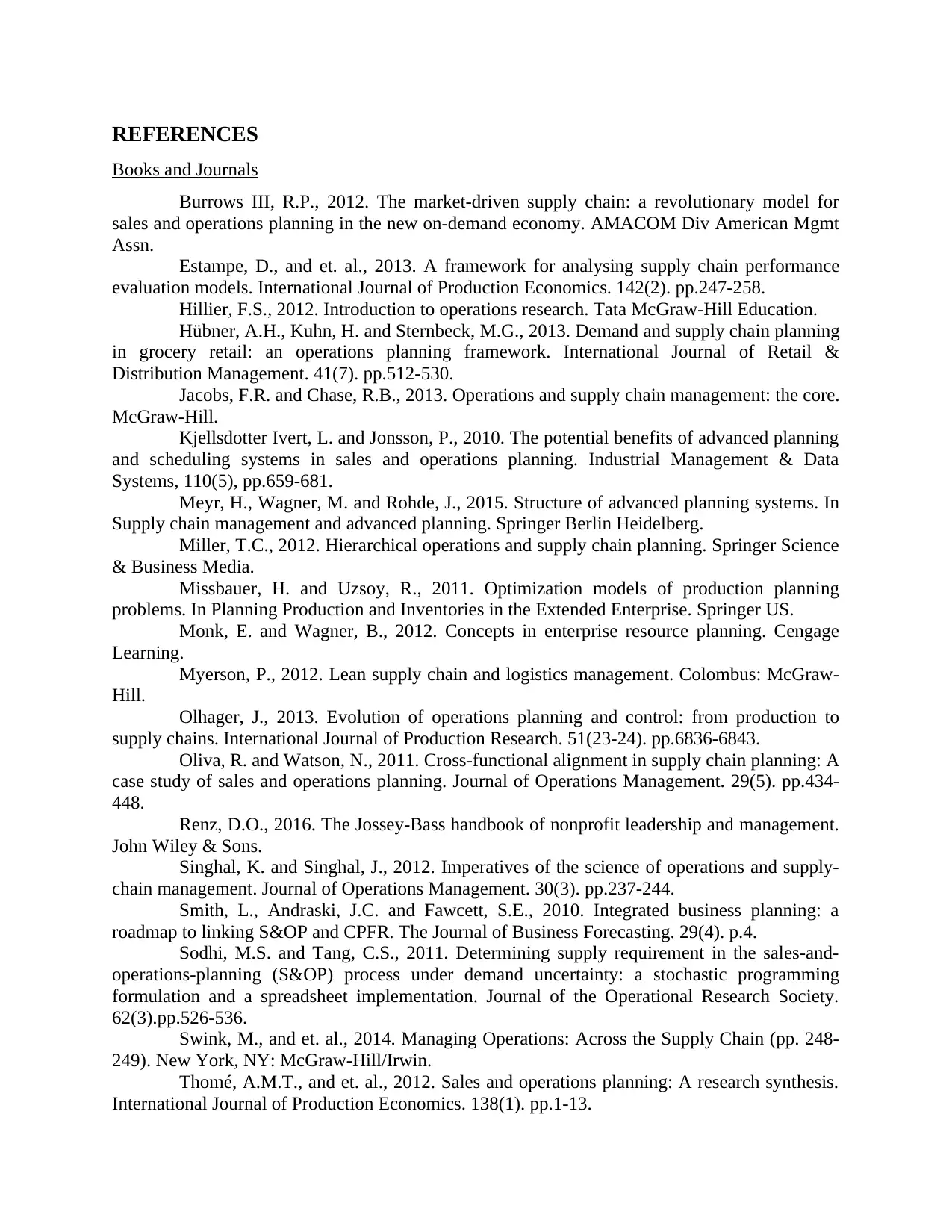
REFERENCES
Books and Journals
Burrows III, R.P., 2012. The market-driven supply chain: a revolutionary model for
sales and operations planning in the new on-demand economy. AMACOM Div American Mgmt
Assn.
Estampe, D., and et. al., 2013. A framework for analysing supply chain performance
evaluation models. International Journal of Production Economics. 142(2). pp.247-258.
Hillier, F.S., 2012. Introduction to operations research. Tata McGraw-Hill Education.
Hübner, A.H., Kuhn, H. and Sternbeck, M.G., 2013. Demand and supply chain planning
in grocery retail: an operations planning framework. International Journal of Retail &
Distribution Management. 41(7). pp.512-530.
Jacobs, F.R. and Chase, R.B., 2013. Operations and supply chain management: the core.
McGraw-Hill.
Kjellsdotter Ivert, L. and Jonsson, P., 2010. The potential benefits of advanced planning
and scheduling systems in sales and operations planning. Industrial Management & Data
Systems, 110(5), pp.659-681.
Meyr, H., Wagner, M. and Rohde, J., 2015. Structure of advanced planning systems. In
Supply chain management and advanced planning. Springer Berlin Heidelberg.
Miller, T.C., 2012. Hierarchical operations and supply chain planning. Springer Science
& Business Media.
Missbauer, H. and Uzsoy, R., 2011. Optimization models of production planning
problems. In Planning Production and Inventories in the Extended Enterprise. Springer US.
Monk, E. and Wagner, B., 2012. Concepts in enterprise resource planning. Cengage
Learning.
Myerson, P., 2012. Lean supply chain and logistics management. Colombus: McGraw-
Hill.
Olhager, J., 2013. Evolution of operations planning and control: from production to
supply chains. International Journal of Production Research. 51(23-24). pp.6836-6843.
Oliva, R. and Watson, N., 2011. Cross-functional alignment in supply chain planning: A
case study of sales and operations planning. Journal of Operations Management. 29(5). pp.434-
448.
Renz, D.O., 2016. The Jossey-Bass handbook of nonprofit leadership and management.
John Wiley & Sons.
Singhal, K. and Singhal, J., 2012. Imperatives of the science of operations and supply-
chain management. Journal of Operations Management. 30(3). pp.237-244.
Smith, L., Andraski, J.C. and Fawcett, S.E., 2010. Integrated business planning: a
roadmap to linking S&OP and CPFR. The Journal of Business Forecasting. 29(4). p.4.
Sodhi, M.S. and Tang, C.S., 2011. Determining supply requirement in the sales-and-
operations-planning (S&OP) process under demand uncertainty: a stochastic programming
formulation and a spreadsheet implementation. Journal of the Operational Research Society.
62(3).pp.526-536.
Swink, M., and et. al., 2014. Managing Operations: Across the Supply Chain (pp. 248-
249). New York, NY: McGraw-Hill/Irwin.
Thomé, A.M.T., and et. al., 2012. Sales and operations planning: A research synthesis.
International Journal of Production Economics. 138(1). pp.1-13.
Books and Journals
Burrows III, R.P., 2012. The market-driven supply chain: a revolutionary model for
sales and operations planning in the new on-demand economy. AMACOM Div American Mgmt
Assn.
Estampe, D., and et. al., 2013. A framework for analysing supply chain performance
evaluation models. International Journal of Production Economics. 142(2). pp.247-258.
Hillier, F.S., 2012. Introduction to operations research. Tata McGraw-Hill Education.
Hübner, A.H., Kuhn, H. and Sternbeck, M.G., 2013. Demand and supply chain planning
in grocery retail: an operations planning framework. International Journal of Retail &
Distribution Management. 41(7). pp.512-530.
Jacobs, F.R. and Chase, R.B., 2013. Operations and supply chain management: the core.
McGraw-Hill.
Kjellsdotter Ivert, L. and Jonsson, P., 2010. The potential benefits of advanced planning
and scheduling systems in sales and operations planning. Industrial Management & Data
Systems, 110(5), pp.659-681.
Meyr, H., Wagner, M. and Rohde, J., 2015. Structure of advanced planning systems. In
Supply chain management and advanced planning. Springer Berlin Heidelberg.
Miller, T.C., 2012. Hierarchical operations and supply chain planning. Springer Science
& Business Media.
Missbauer, H. and Uzsoy, R., 2011. Optimization models of production planning
problems. In Planning Production and Inventories in the Extended Enterprise. Springer US.
Monk, E. and Wagner, B., 2012. Concepts in enterprise resource planning. Cengage
Learning.
Myerson, P., 2012. Lean supply chain and logistics management. Colombus: McGraw-
Hill.
Olhager, J., 2013. Evolution of operations planning and control: from production to
supply chains. International Journal of Production Research. 51(23-24). pp.6836-6843.
Oliva, R. and Watson, N., 2011. Cross-functional alignment in supply chain planning: A
case study of sales and operations planning. Journal of Operations Management. 29(5). pp.434-
448.
Renz, D.O., 2016. The Jossey-Bass handbook of nonprofit leadership and management.
John Wiley & Sons.
Singhal, K. and Singhal, J., 2012. Imperatives of the science of operations and supply-
chain management. Journal of Operations Management. 30(3). pp.237-244.
Smith, L., Andraski, J.C. and Fawcett, S.E., 2010. Integrated business planning: a
roadmap to linking S&OP and CPFR. The Journal of Business Forecasting. 29(4). p.4.
Sodhi, M.S. and Tang, C.S., 2011. Determining supply requirement in the sales-and-
operations-planning (S&OP) process under demand uncertainty: a stochastic programming
formulation and a spreadsheet implementation. Journal of the Operational Research Society.
62(3).pp.526-536.
Swink, M., and et. al., 2014. Managing Operations: Across the Supply Chain (pp. 248-
249). New York, NY: McGraw-Hill/Irwin.
Thomé, A.M.T., and et. al., 2012. Sales and operations planning: A research synthesis.
International Journal of Production Economics. 138(1). pp.1-13.

Online
Six Key Benefits Trade Shows Have To Market Your Business. 2014. [Online].
Available Through: <http://www.business2community.com/marketing/six-key-benefits-trade-
shows-market-business-0973628>. [Accessed On 1 May 2017].
The Advantages of Marketing Internationally. 2017. [Online]. Available Through:
<http://smallbusiness.chron.com/advantages-marketing-internationally-61158.html>. [Accessed
On 1 May 2017]
Six Key Benefits Trade Shows Have To Market Your Business. 2014. [Online].
Available Through: <http://www.business2community.com/marketing/six-key-benefits-trade-
shows-market-business-0973628>. [Accessed On 1 May 2017].
The Advantages of Marketing Internationally. 2017. [Online]. Available Through:
<http://smallbusiness.chron.com/advantages-marketing-internationally-61158.html>. [Accessed
On 1 May 2017]
⊘ This is a preview!⊘
Do you want full access?
Subscribe today to unlock all pages.

Trusted by 1+ million students worldwide
1 out of 12
Related Documents
Your All-in-One AI-Powered Toolkit for Academic Success.
+13062052269
info@desklib.com
Available 24*7 on WhatsApp / Email
![[object Object]](/_next/static/media/star-bottom.7253800d.svg)
Unlock your academic potential
Copyright © 2020–2025 A2Z Services. All Rights Reserved. Developed and managed by ZUCOL.





